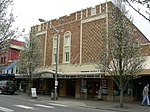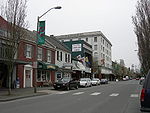Cascade Mall
1990 establishments in Washington (state)Burlington, WashingtonCompanies disestablished due to the COVID-19 pandemicDefunct shopping malls in the United StatesShopping malls disestablished in 2020 ... and 4 more
Shopping malls established in 1990Shopping malls in Washington (state)Tourist attractions in Skagit County, WashingtonUse mdy dates from September 2016
Cascade Mall was an enclosed shopping mall in Burlington, Washington, United States. Opened in November 1989, the mall's anchor stores are AMC Theatres and TJ Maxx. There are 4 vacant anchor stores that were once 2 Macy's stores, Sears, and JCPenney. Macerich owned the property before selling it to Merlone Geier Partners in January 2017. The mall permanently closed on June 30, 2020, due to the COVID-19 pandemic. Some stores will be allowed to stay open if they provide essential services, including those on the outer perimeter.
Excerpt from the Wikipedia article Cascade Mall (License: CC BY-SA 3.0, Authors).Cascade Mall
Cascade Mall Drive,
Geographical coordinates (GPS) Address Phone number Website External links Nearby Places Show on map
Geographical coordinates (GPS)
| Latitude | Longitude |
|---|---|
| N 48.46221 ° | E -122.33929 ° |
Address
Cascade Mall
Cascade Mall Drive 201
98233
Washington, United States
Open on Google Maps







